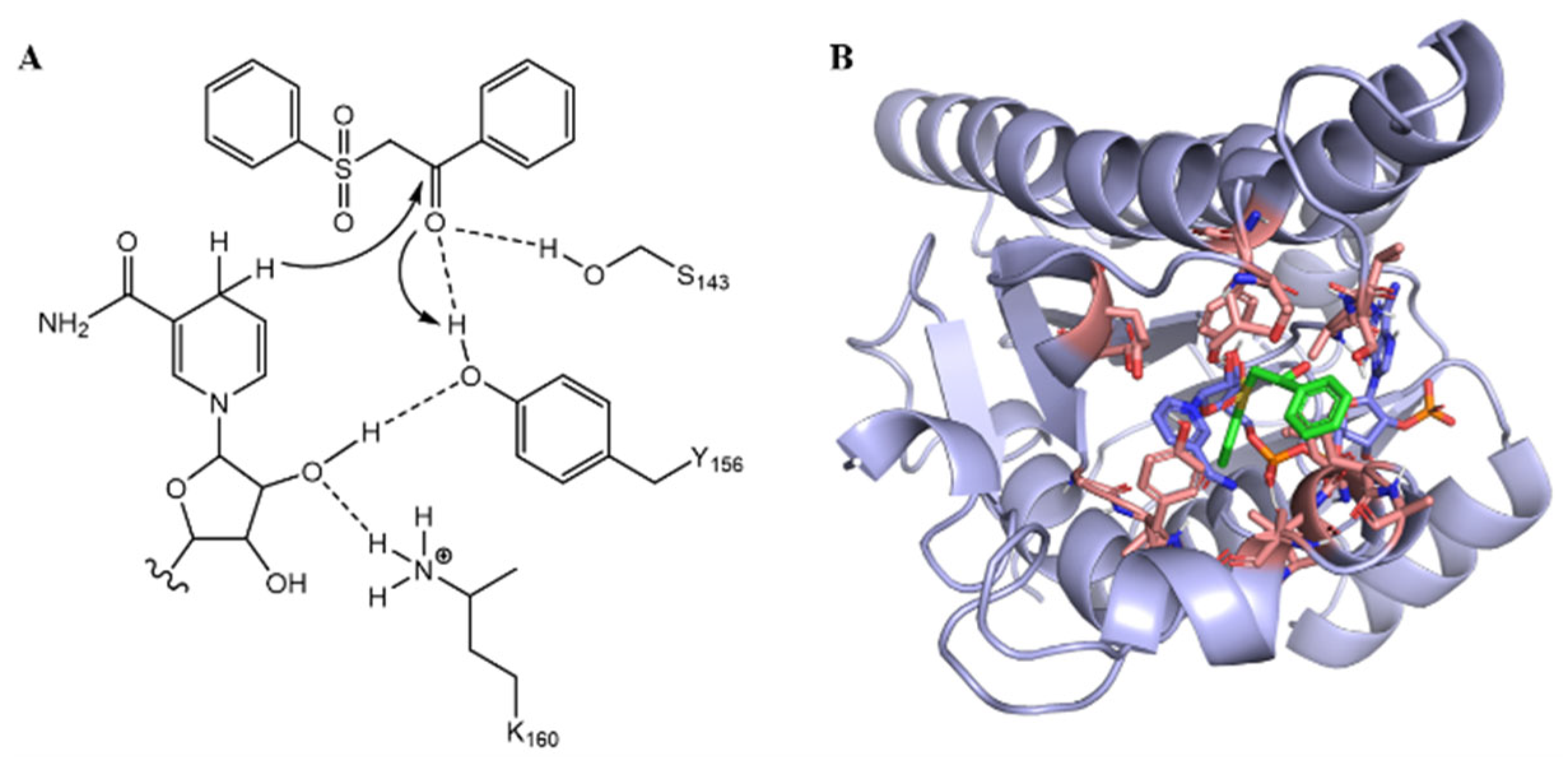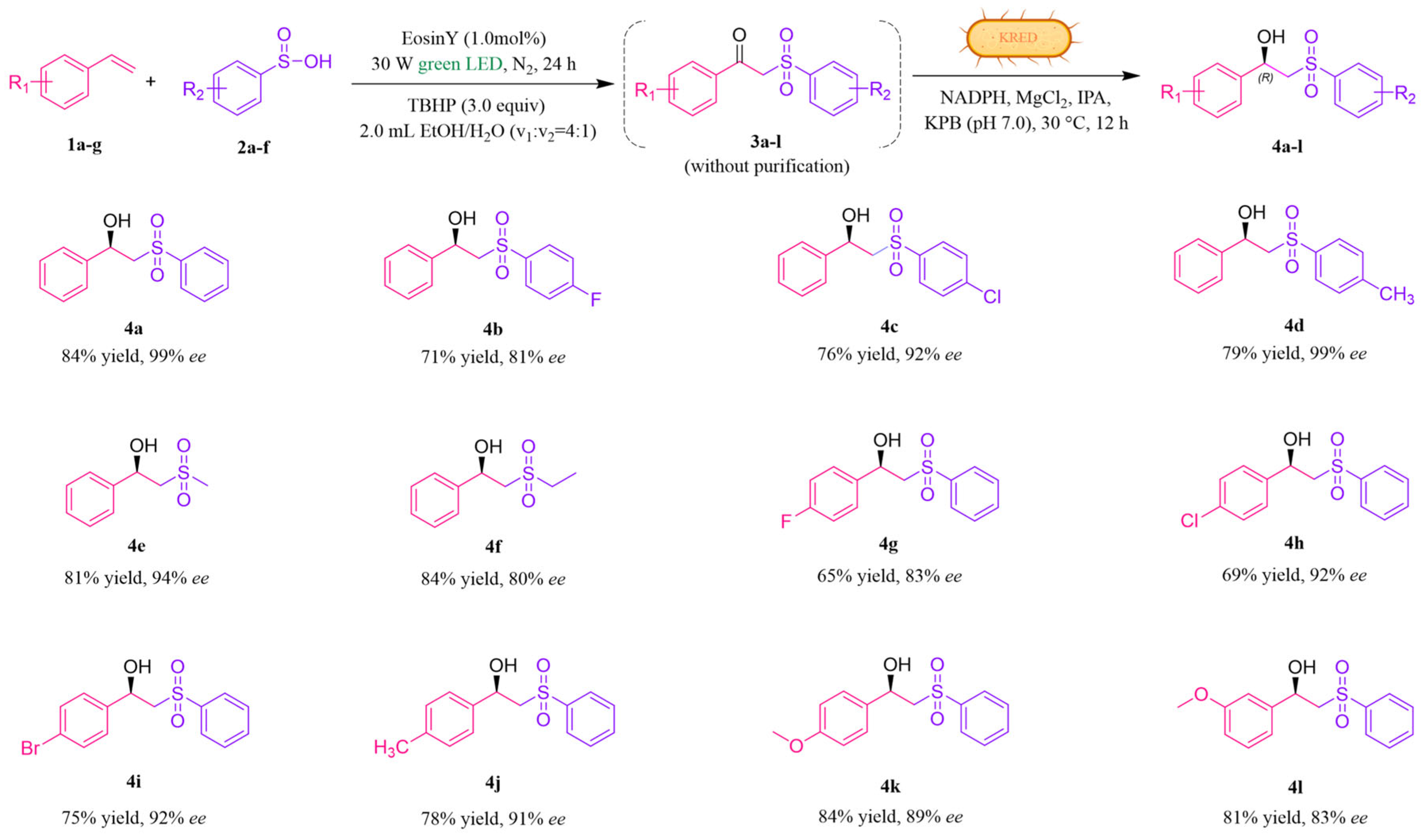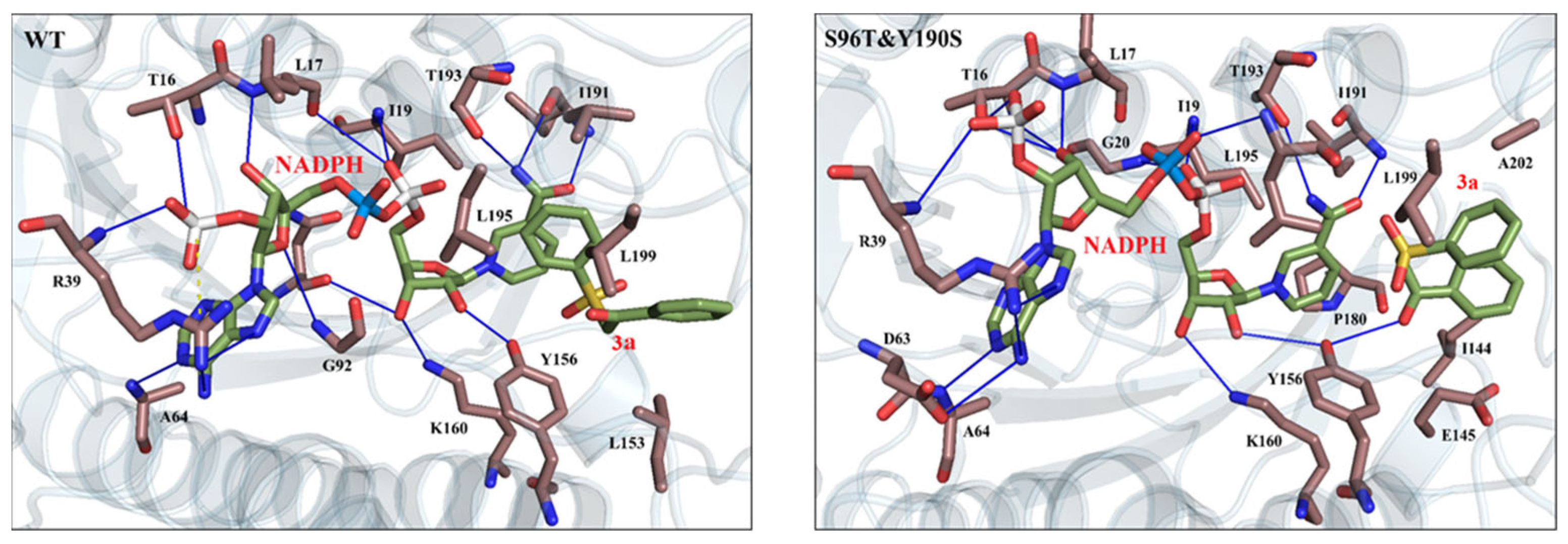Photo-Biocatalytic One-Pot Cascade Reaction for the Asymmetric Synthesis of Hydroxysulfone Compounds
Abstract
1. Introduction
2. Results and Discussion
2.1. Reshaping the Substrate Binding Region of LkKRED
2.2. The One-Pot Photo-Enzymatic Cascade System of β and γ-Hydroxysulfones
2.3. Molecular Dynamics Simulation Analysis of LKKRED and Its Mutants
3. Materials and Methods
3.1. Mutant Library Construction and Expression of KREDs
3.2. Synthesis of Ketosulfones and Racemic Hydroxysulfones
3.3. Asymmetric Screening for the Variants
3.4. Procedure of the One-Pot Photo-Enzymatic Cascade System
3.5. Molecular Dynamics Simulations
4. Conclusions
Supplementary Materials
Author Contributions
Funding
Data Availability Statement
Conflicts of Interest
References
- Fuchs, P.L.; Braish, T.F. Multiply convergent syntheses via conjugate-addition reactions to cycloalkenyl sulfones. Chem. Rev. 1986, 86, 903–917. [Google Scholar] [CrossRef]
- Gais, H.-J.; von der Weiden, I.; Fleischhauer, J.; Esser, J.; Raabe, G. Lipase catalyzed resolution of α-hydroxymethyl sulfones. Determination of absolute configuration by semiempirical calculation of CD spectra and verification by X-ray structure analysis. Tetrahedron Asymmetry 1997, 8, 3111–3123. [Google Scholar] [CrossRef]
- Catto, M.; Aliano, R.; Carotti, A.; Cellamare, S.; Palluotto, F.; Purgatorio, R.; De Stradis, A.; Campagna, F. Design, synthesis and biological evaluation of indane-2-arylhydrazinylmethylene-1,3-diones and indol-2-aryldiazenylmethylene-3-ones as β-amyloid aggregation inhibitors. Eur. J. Med. Chem. 2010, 45, 1359–1366. [Google Scholar] [CrossRef]
- Fujimoto, T.; Imaeda, Y.; Konishi, N.; Hiroe, K.; Kawamura, M.; Textor, G.P.; Aertgeerts, K.; Kubo, K. Discovery of a Tetrahy-dropyrimidin-2(1H)-one Derivative (TAK-442) as a Potent, Selective, and Orally Active Factor Xa Inhibitor. J. Med. Chem. 2010, 53, 3517–3531. [Google Scholar] [CrossRef]
- Shinozawa, E.; Nakayama, M.; Imura, Y. TAK-442, a Direct Factor Xa Inhibitor, Inhibits Monocyte Chemoattractant Protein 1 Production in Endothelial Cells via Involvement of Protease-Activated Receptor 1. Front. Pharmacol. 2018, 9, 1431. [Google Scholar] [CrossRef]
- Devasthale, P.; Wang, W.; Mignone, J.; Renduchintala, K.; Radhakrishnan, S.; Dhanapal, J.; Selvaraj, J.; Kuppusamy, R.; Pelleymounter, M.A.; Longhi, D.; et al. Non-basic azolotriazinone MCHR1 antagonists for the treatment of obesity: An empirical brain-exposures-driven candidate selection for in vivo efficacy studies. Bioorg. Med. Chem. Lett. 2015, 25, 4412–4418. [Google Scholar] [CrossRef]
- Narode, H.; Gayke, M.; Eppa, G.; Yadav, J.S. A Review on Synthetic Advances toward the Synthesis of Apremilast, an Anti-inflammatory Drug. Org. Process Res. Dev. 2021, 25, 1512–1523. [Google Scholar] [CrossRef]
- Choi, O.K.; Cho, B.T. An efficient synthesis of enantiopure 3-chlorostyrene oxide via oxazaborolidine-catalyzed reduction. Org. Prep. Proced. Int. 2000, 32, 493–497. [Google Scholar] [CrossRef]
- Cho, B.T.; Kim, D.J. Efficient synthesis of optically active β-hydroxy p-tolylsulfones with very high enantiomeric excess via CBS–oxazaborolidine-catalyzed borane reduction. Tetrahedron Asymmetry 2001, 12, 2043–2047. [Google Scholar] [CrossRef]
- Zhao, G.; Hu, J.-B.; Qian, Z.-S.; Yin, W.-X. Enantioselective reduction of β-keto sulfones using the NaBH4/Me3SiCl system catalyzed by polymer-supported chiral sulfonamide. Tetrahedron Asymmetry 2002, 13, 2095–2098. [Google Scholar] [CrossRef]
- Wan, X.; Meng, Q.; Zhang, H.; Sun, Y.; Fan, W.; Zhang, Z. An Efficient Synthesis of Chiral β-Hydroxy Sulfones via Ru-Catalyzed Enantioselective Hydrogenation in the Presence of Iodine. Org. Lett. 2007, 9, 5613–5616. [Google Scholar] [CrossRef] [PubMed]
- Zhang, H.-L.; Hou, X.-L.; Dai, L.-X.; Luo, Z.-B. Synthesis of a biferrocene diphosphine ligand with only planar chirality and its application in the Rh-catalyzed asymmetric hydrogenation of β-keto sulfones. Tetrahedron Asymmetry 2007, 18, 224–228. [Google Scholar] [CrossRef]
- Huang, X.-F.; Zhang, S.-Y.; Geng, Z.-C.; Kwok, C.-Y.; Liu, P.; Li, H.-Y.; Wang, X.-W. Asymmetric Hydrogenation of β-Keto Sulfonamides and β-Keto Sulfones with a Chiral Cationic Ruthenium Diamine Catalyst. Adv. Synth. Catal. 2013, 355, 2860–2872. [Google Scholar] [CrossRef]
- Cui, P.; Liu, Q.; Wang, J.; Liu, H.; Zhou, H. One-pot synthesis of chiral β-hydroxysulfones from alkynes via aerobic oxysulfonylation and asymmetric reduction in MeOH/H2O. Green Chem. 2019, 21, 634–639. [Google Scholar] [CrossRef]
- Tao, L.; Yin, C.; Dong, X.-Q.; Zhang, X. Efficient synthesis of chiral β-hydroxy sulfones via iridium-catalyzed hydrogenation. Org. Biomol. Chem. 2019, 17, 785–788. [Google Scholar] [CrossRef]
- Nobukazu, T. Aerobic Nickel-Catalyzed Hydroxysulfonylation of Alkenes Using Sodium Sulfinates. J. Org. Chem. 2015, 80, 7797–7802. [Google Scholar] [CrossRef]
- Rao, H.W.; Gao, C.; Jiang, L.L.; Ma, X.X.; Xu, R.J.; Li, J.; Dong, W.X.; Li, W.Y.; Zou, D.G. Aerobic Copper-Catalyzed Hydroxysulfonylation of Vinylarenes with Sodium Sulfinates. J. Org. Chem. 2025, 90, 1489–1500. [Google Scholar] [CrossRef] [PubMed]
- Ding, Z.; Yang, J.; Wang, T.; Shen, Z.; Zhang, Y. Dynamic kinetic resolution of β-keto sulfones via asymmetric transfer hydrogenation. Chem. Commun. 2009, 5, 571–573. [Google Scholar] [CrossRef]
- Zhang, D.; Cheng, T.; Zhao, Q.; Xu, J.; Liu, G. Highly Enantioselective One-Pot Synthesis of Chiral β-Hydroxy Sulfones via Asymmetric Transfer Hydrogenation in an Aqueous Medium. Org. Lett. 2014, 16, 5764–5767. [Google Scholar] [CrossRef]
- Wang, J.; Wu, L.; Hu, X.; Liu, R.; Jin, R.; Liu, G. One-pot synthesis of optically pure β-hydroxy sulfones via a heterogeneous ruthenium/diamine-promoted nucleophilic substitution-asymmetric transfer hydrogenation tandem process. Catal. Sci. Technol. 2017, 7, 4444–4450. [Google Scholar] [CrossRef]
- Vyas, V.K.; Srivastava, P.; Bhatt, P.; Shende, V.; Ghosh, P.; Bhanage, B.M. Highly Enantioselective One-Pot Synthesis of Chiral β-Heterosubstituted Alcohols via Ruthenium–Prolinamide-Catalyzed Asymmetric Transfer Hydrogenation. ACS Omega 2018, 3, 12737–12745. [Google Scholar] [CrossRef]
- Xiong, Z.; Pei, C.; Xue, P.; Lv, H.; Zhang, X. Highly enantioselective transfer hydrogenation of racemic α-substituted β-keto sulfonamides via dynamic kinetic resolution. Chem. Commun. 2018, 54, 3883–3886. [Google Scholar] [CrossRef]
- Wang, S.; Wang, C.; Lv, N.; Tan, C.; Cheng, T.; Liu, G. A Compartmentalized-type Bifunctional Magnetic Catalyst for One-pot Aerobic Oxysulfonylation and Asymmetric Transfer Hydrogenation. ChemCatChem 2021, 13, 909–915. [Google Scholar] [CrossRef]
- Friestad, G.K.; Sreenilayam, G. Versatile configuration-encoded strategy for rapid synthesis of 1,5-polyol stereoisomers. Org. Lett. 2010, 12, 5016–5019. [Google Scholar] [CrossRef]
- Kiełbasiński, P.; Rachwalski, M.; Mikołajczyk, M.; Moelands, M.A.H.; Zwanenburg, B.; Rutjes, F.P.J.T. Lipase-promoted dynamic kinetic resolution of racemic β-hydroxyalkyl sulfones. Tetrahedron Asymmetry 2005, 16, 2157–2160. [Google Scholar] [CrossRef]
- Jacobs, H.K.; Mueller, B.H.; Gopalan, A.S. Chiral γ and δ Hydroxysulfones via lipase catalyzed resolutions-synthesis of (R)(+)-4-hexanolide and (2R,5S)-2-methyl-5-hexanolide using intramolecular acylation. Tetrahedron 1992, 48, 8891–8898. [Google Scholar] [CrossRef]
- Lorraine, K.; King, S.; Greasham, R.; Chartrain, M. Asymmetric bioreduction of a ketosulfone to the corresponding trans-hydroxysulfone by the yeast Rhodotorula rubra MY 2169. Enzym. Microb. Technol. 1996, 19, 250–255. [Google Scholar] [CrossRef] [PubMed]
- Stahl, S.; Tillyer, R.; King, A.; Dagneau, P.; Wang, X.; O’Shea, P.; Greasham, R.; Chartrain, M. Asymmetric Bioreduction of an Allylic Ketosulfone to its Corresponding (R)-Alcohol. Bio-Catal. Biotransform. 2000, 18, 471–477. [Google Scholar] [CrossRef]
- Huisman, G.W.; Liang, J.; Krebber, A. Practical chiral alcohol manufacture using ketoreductases. Curr. Opin. Chem. Biol. 2010, 14, 122–129. [Google Scholar] [CrossRef]
- Bornscheuer, U.T.; Huisman, G.W.; Kazlauskas, R.J.; Lutz, S.; Moore, J.C.; Robins, K. Engineering the third wave of biocataly-sis. Nature 2012, 485, 185–194. [Google Scholar] [CrossRef]
- Ni, Y.; Xu, J.-H. Biocatalytic ketone reduction: A green and efficient access to enantiopure alcohols. Biotechnol. Adv. 2012, 30, 1279–1288. [Google Scholar] [CrossRef]
- Hughes, G.; Lewis, J.C. Introduction: Biocatalysis in Industry. Chem. Rev. 2018, 118, 1–3. [Google Scholar] [CrossRef]
- Hollmann, F.; Opperman, D.J.; Paul, C.E. Biocatalytic Re-duction Reactions from a Chemist’s Perspective. Angew. Chem. Int. Ed. 2021, 60, 5644–5665. [Google Scholar] [CrossRef] [PubMed]
- Li, Z.; Yang, H.; Liu, J.; Huang, Z.; Chen, F. Application of Ketoreductase in Asymmetric Synthesis of Pharmaceuticals and Bioactive Molecules: An Update (2018–2020). Chem. Rec. 2021, 21, 1611–1630. [Google Scholar] [CrossRef]
- Wu, S.; Snajdrova, R.; Moore, J.C.; Baldenius, K.; Bornscheuer, U.T. Biocatalysis: Enzymatic Synthesis for Industrial Applications. Angew. Chem. Int. Ed. 2021, 60, 88–119. [Google Scholar] [CrossRef] [PubMed]
- Huang, C.; Liu, J.; Fang, J.; Jia, X.; Zheng, Z.; You, S.; Qin, B. Ketoreductase Catalyzed (Dynamic) Kinetic Resolution for Bi-omanufacturing of Chiral Chemicals. Front. Bioeng. Biotechnol. 2022, 10, 929784. [Google Scholar]
- Zheng, C.; Wang, Z.; Wang, Q.; Wang, S.; Lao, S.; He, J.; Chen, Z. Efficient preparation of the chiral intermediate of luliconazole with Lactobacillus kefir alcohol dehydrogenase through rational rearrangement of the substrate binding pocket. Mol. Catal. 2021, 509, 111639. [Google Scholar] [CrossRef]
- Yuan, Q.; Ma, L.; Kong, W.; Liu, J.; Zhang, S.; Yan, J.; Bai, J.; He, Y.; Zhou, L.; Liu, Y.; et al. Enzymatic synthesis of chiral alco-hols using ketoreductases. Catal. Rev. 2024, 67, 283–322. [Google Scholar] [CrossRef]
- Shaw, M.H.; Twilton, J.; MacMillan, D.W.C. Photoredox Catalysis in Organic Chemistry. J. Org. Chem. 2016, 81, 6898–6926. [Google Scholar] [CrossRef]
- Romero, N.A.; Nicewicz, D.A. Organic Photoredox Catalysis. Chem. Rev. 2016, 116, 10075–10166. [Google Scholar] [CrossRef]
- Narayanam, J.M.R.; Stephenson, C.R.J. Visible light photoredox catalysis: Applications in organic synthesis. Chem. Soc. Rev. 2011, 40, 102–113. [Google Scholar] [CrossRef]
- Marzo, L.; Pagire, S.K.; Reiser, O.; König, B. Visible-Light Photocatalysis: Does It Make a Difference in Organic Synthesis? Angew. Chem. Int. Ed. 2018, 57, 10034–10072. [Google Scholar] [CrossRef]
- Prier, C.K.; Rankic, D.A.; MacMillan, D.W.C. Visible Light Photoredox Catalysis with Transition Metal Complexes: Applications in Organic Synthesis. Chem. Rev. 2013, 113, 5322–5363. [Google Scholar] [CrossRef]
- Strieth-Kalthoff, F.; Glorius, F. Triplet Energy Transfer Photocatalysis: Unlocking the Next Level. Chem 2020, 6, 1888–1903. [Google Scholar] [CrossRef]
- Fu, Y.; Liu, X.; Xia, Y.; Guo, X.; Guo, J.; Zhang, J.; Zhao, W.; Wu, Y.; Wang, J.; Zhong, F. Whole-cell-catalyzed hydrogena-tion/deuteration of aryl halides with a genetically repurposed photodehalogenase. Chem 2023, 9, 1897–1909. [Google Scholar] [CrossRef]
- Emmanuel, M.A.; Bender, S.G.; Bilodeau, C.; Carceller, J.M.; DeHovitz, J.S.; Fu, H.; Liu, Y.; Nicholls, B.T.; Ouyang, Y.; Page, C.G.; et al. Photobiocatalytic Strategies for Organic Synthesis. Chem. Rev. 2023, 123, 5459–5520. [Google Scholar] [CrossRef] [PubMed]
- Xie, S.; Zhang, C.; Dai, Y.; Li, F.; Wang, L.; Chen, P.; Wang, Z. Hemoglobin: An efficient oxidase for the green synthesis of quinazoline derivatives by biocatalytic domino strategy. Mol. Catal. 2025, 570, 114680. [Google Scholar] [CrossRef]
- Li, F.; Xu, Y.; Liu, Y.; Kan, W.; Piao, Y.; Han, W.; Li, Z.; Wang, Z.; Wang, L. Switching engineered Vitreoscilla hemoglobin into carbene transferase for enantioselective SH insertion. Int. J. Biol. Macromol. 2024, 278, 134756. [Google Scholar] [CrossRef]
- Xie, H.; Li, F.; Xu, Y.; Wang, C.; Xu, Y.; Wu, J.; Li, Z.; Wang, Z.; Wang, L. Vitreoscilla hemoglobin: A natural carbene transfer catalyst for diastereo- and enantioselective synthesis of nitrile-substituted cyclopropanes. Green Chem. 2023, 25, 6853–6858. [Google Scholar] [CrossRef]
- Ma, J.; Li, F.; Wang, C.; Wang, Z.; Du, C.; Wang, L. Synthesis of Isothiocyanates from Primary Amines via Visible-Light Photocatalysis. Org. Lett. 2023, 25, 5692–5696. [Google Scholar] [CrossRef]
- Yang, D.; Huang, B.; Wei, W.; Li, J.; Lin, G.; Liu, Y.; Ding, J.; Sun, P.; Wang, H. Visible-light initiated direct oxysulfonylation of alkenes with sulfinic acids leading to β-ketosulfones. Green Chem. 2016, 18, 5630–5634. [Google Scholar] [CrossRef]
- Mou, Q.; Han, T.; Liu, M. Light-Driven Three-Component Carbonylation of Aryl Halides Using Abundant Metal Carbonyl. Org. Lett. 2024, 26, 2169–2174. [Google Scholar] [CrossRef] [PubMed]
- López-Agudo, M.; Ríos-Lombardía, N.; González-Sabín, J.; Lavandera, I.; Gotor-Fernández, V. Chemoenzymatic Oxosulfonylation-Bioreduction Sequence for the Stereoselective Synthesis of β-Hydroxy Sulfones. ChemSusChem 2022, 15, e202101313. [Google Scholar] [CrossRef] [PubMed]
- Wang, Y.; Jiang, W.; Huo, C. One-Pot Synthesis of β-Hydroxysulfones and Its Application in the Preparation of Anticancer Drug Bicalutamide. J. Org. Chem. 2017, 82, 10628–10634. [Google Scholar] [CrossRef] [PubMed]
- Guo, J.; Gao, X.; Qian, D.; Wang, H.; Jia, X.; Zhang, W.; Qin, B.; You, S. Efficient synthesis of an apremilast precursor and chiral β-hydroxy sulfones via ketoreductase-catalyzed asymmetric reduction. Org. Biomol. Chem. 2022, 20, 2081–2085. [Google Scholar] [CrossRef]
- Jeremias, N.; Mohr, L.-M.; Bach, T. Intermolecular [2+2] Photocycloaddition of α,β-Unsaturated Sulfones: Catalyst-Free Reaction and Catalytic Variants. Org. Lett. 2021, 23, 5674–5678. [Google Scholar] [CrossRef]
- Nwaukwa, S.O.; Lee, S.; Keehn, P.M. Epoxide Ring Opening by α-Sulfonyl Carbanions. Synthesis of γ-Hydroxy Sulfones and Triflones. Synth. Commun. 1986, 16, 309–329. [Google Scholar] [CrossRef]








Disclaimer/Publisher’s Note: The statements, opinions and data contained in all publications are solely those of the individual author(s) and contributor(s) and not of MDPI and/or the editor(s). MDPI and/or the editor(s) disclaim responsibility for any injury to people or property resulting from any ideas, methods, instructions or products referred to in the content. |
© 2025 by the authors. Licensee MDPI, Basel, Switzerland. This article is an open access article distributed under the terms and conditions of the Creative Commons Attribution (CC BY) license (https://creativecommons.org/licenses/by/4.0/).
Share and Cite
Qiao, X.; Pei, Q.; Dai, Y.; Wang, L.; Wang, Z. Photo-Biocatalytic One-Pot Cascade Reaction for the Asymmetric Synthesis of Hydroxysulfone Compounds. Catalysts 2025, 15, 733. https://doi.org/10.3390/catal15080733
Qiao X, Pei Q, Dai Y, Wang L, Wang Z. Photo-Biocatalytic One-Pot Cascade Reaction for the Asymmetric Synthesis of Hydroxysulfone Compounds. Catalysts. 2025; 15(8):733. https://doi.org/10.3390/catal15080733
Chicago/Turabian StyleQiao, Xuebin, Qianqian Pei, Yihang Dai, Lei Wang, and Zhi Wang. 2025. "Photo-Biocatalytic One-Pot Cascade Reaction for the Asymmetric Synthesis of Hydroxysulfone Compounds" Catalysts 15, no. 8: 733. https://doi.org/10.3390/catal15080733
APA StyleQiao, X., Pei, Q., Dai, Y., Wang, L., & Wang, Z. (2025). Photo-Biocatalytic One-Pot Cascade Reaction for the Asymmetric Synthesis of Hydroxysulfone Compounds. Catalysts, 15(8), 733. https://doi.org/10.3390/catal15080733







